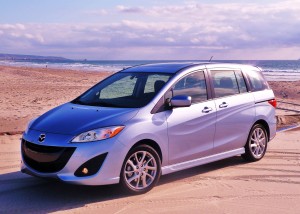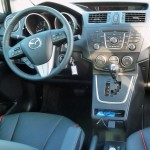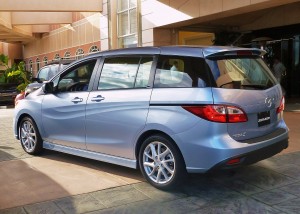Mazda5 a mini-minivan with Zoom-Zoom
By John Gilbert
SAN DIEGO, CALIF. — Through good times and bad, Mazda has held true to its ‘Zoom-Zoom” image. Its vehicles may vary, but they always rank high in the fun-to-drive quotient. The 2012Â Mazda5 shines as the latest example, proving that even a mini-minivan can zoom.
Mazda would prefer to call the Mazda5 a “Multi-Activity Vehicle,” but the chances of adding MAV to the consumers’ automotive lexicon is remote. Mazda officials therefore won’t shrink from accepting similarities to a shrink-wrapped minivan. Other companies might be reluctant to promote minivans these days, and while I think it’s a stretch to call the Mazda5 a minivan, but Robert Davis, senior vice president of production, development and quality, says the Mazda5 has “the body of a minivan and the soul of a sports car.”
On the other hand, Tetsu Nakazawa, Mazda’s manager of product planning and strategy, says: “The Mazda5 does not fit into any segment. It’s characterized as a minivan by some because of the seat arrangement, while others say it’s a compact in the C Segment, and Consumer Reports calls it a wagon. It is the hidden gem in our lineup, because people who look at it expect two rows of seats and find three rows, then they are surprised at how fun it is to drive, and they are further surprised because its price starts at under $20,000.”
And they didn’t even get into one of my favorite asset, which is sliding side doors, which could be called parking-lot proof.
Officially, the base price is $19,990, although to stay $10 under $20,000, Mazda makes you add the $795 destination price yourself. Still, the standard equipment is a lengthy and impressive list. The basic Mazda5 is the Sport, which has 16-inch alloy wheels, power windows, locks and cruise control, plus keyless entry. Next up is the Touring model, which comes with the 5-speed automatic standard and 17-inch wheels, optional on the Sport, are standard, as are Bluetooth connectivity, foglights, and a rear spoiler. The Grand Touring is above that, with leather heated seats, a power moonroof, rain-sensing wipers, a 6-CD changer, and anti-theft devices. The moonroof and audio packages are options.
Mazda engines have long been a standard of smooth power and efficiency, and the 4 has been worthy of becoming the basis for Ford’s 4-cylinder family of engines that include the new Focus up through the Escape and Fusion. In fact, Ford is about to introduce its C-Max, which is a vehicle that closely resembles the Mazda5. Meanwhile, the venerable Mazda 2.3-liter engine has grown into the MZR 2.5-liter unit, with dual-overhead camshafts, four valves per cylinder, and variable valve-timing. Power increases by 5 to 157 horsepower at 6,000 RPMs and by 15, to 163 foot-pounds of torque at 4,000 revs, compared to the 2.3. Fuel economy is up 1 mpg, to 21 city and 28 highway with a new 6-speed manual that replaces the previous 5-speed, or a smooth-shifting 5-speed automatic that has an adjusted final-drive ratio.
That power is more than adequate to zip the light and lean Mazda5 through its appointed front-wheel-drive rounds. Driving a Mazda is always interesting, because the fun quotient always renders the actual numbers of power and performance nonessential. Normal driving is fine, including high-speed freeway cruising, but aggessive driving — throwing the Mazda5 around curves, or powering around tightly twisting highways — provides the best evidence of predictably linear acceleration, steering, braking and stability. With Mazdas, it’s always impossible to gauge by the numerical listing for power, because the reality of driving is always greater than the anticipation from those numbers.
In the Mazda5, the perceptions are notably unique because engineers actually softened the cornering slightly. With a more rigid chassis, the MacPherson strut front and multilink rear suspension has benefitted by changing the damper settings and spring rates, and retuning the electronic hydraulic power steering, all of which makes the Mazda5 roll slightly more in abrupt cornering. It feels fine, and is always predictable, while solving complaints that front passengers were being flung from side to side in sharp corners because the previous model was too stiff. Face it, you will have a more harmonious ride home if every time you decide to zip around a curve, your wife doesn’t find her face up against the side window glass.
Amid the endless list of versatility and affordability features, my favorite remains the sliding side doors. Some day, maybe all sorts of large and midsize sedans will have sliding side doors.
It seems as though half of your parking is done in lots which are striped too close to each other by someone who think it’s profitable to cram more cars into a given space, and never mind that such a design assures that everytime a car door opens, it creates that unique American feature — the “parking lot ding.” Minivans don’t inflict such dings and dents, because they have side doors that slide, sometimes with power-boosted, push-button efficiency, rather than swinging opening 4 feet into the adjoining space.
Imagine instead pulling into your favorite shopping center, and you get out of your midsize sedan or SUV, and after getting out, you let kids or other rear-seat occupants out by simply sliding the rear door open, rather than opening it 75 percent of the way to avoid whacking that adjacent car. I find myself asking engineers and designers why midsize and large sedans don’t consider sliding side doors, they all scoff at the notion and talk about the added mechanism required to operate it.
As minivans lost favor when SUVs took over, there were fewer sliding side doors, brilliant though they are in concept and execution. Except in the Mazda5. As a compact little wagon-like vehicle, it is shaped like a downsized minivan, and it has sliding side doors that allow easy access to the second or third rows of seats. Unfortunately, in our image-conscious society, people pretty much ignored the Mazda5 as an — ugh! — minivan, because if it has sliding side doors, it MUST be a minivan.
Altogether, sales of the Mazda5 were up 11 percent for “last year,” although it was a long last year. There was no 2011 model, as the company, like many others a year ago, had more inventory than demand, and simply kept selling what they had without any change. The new Mazda5 is a 2012 model, and it is, officially, the second-generation Mazda5. Other manufacturers have wavered between big and small cars, economical and gas guzzlers, boring and fun-to-drive cars, useful and silly vehicles. But Mazda has its “Zoom-Zoom” trademark, which implies that fun-to-drive is foremost. And it is. You’ve got to love Mazda, and the new 2012 Mazda5 is the perfect reason why.
A few years ago, Mazda switched all of its vehicle designations. The Mazda6 became its mainline midsize sedan, Mazda3 its compact, the Tribute as its compact crossover SUV, and it is still trying to convince people to call the lovable Miata sports car the MX-5. Of course, the RX-8 sports car remains with its unique rotary engine. In the meantime, Mazda quit building its various attempts at a minivan and came out with a very neat array of crossover utility vehicles, including the CX-7 and the CX-9, a pair of stylish but potent crossovers.
The Mazda5 plugged into a gap that some may not have recognized. It was shaped, approximately, like a minivan, except that it was much smaller — more like a compact sedan that had a snub nose and had been stretched out to a wagon-like rear end. It was very useful as a high-mileage commuter, or as a family hauler, with a lot of versatility. Mazda’s timing has been good, because the two most recent introductions have been for the Mazda2, a subcompact that is high-mileage but still fun to drive, and now the second-gen Mazda5.
The Mazda5 is based on the C1 global platform, which underpins the Mazda3. As you walk up to the Mazda5, the first thing that catches your eye are stylish contours carved into the sides in very artistic little swirls. After we finished test-driving various models of the Mazda5 and returned to our San Diego harborside hotel, I actually walked up to a parked Mazda5 and ran my fingers across the side, just to be sure that those were contours and not cleverly designed decals. Designer Ken Sawaid, who works out of Mazda’s Irvine, Calif., design studio, said the contours and the entire exterior followed Mazda’s Nagare concept design scheme, which translates to the flow of water, or blown sand, or fabric in the wind.
“There is some Nagare influence in the Mazda3 and Mazda6, but the Mazda5 is the first vehicle with overall Nagare style,” Sawaid said. The hood area, the A pillars, the grille, and all openings were dependent on wind-tunnel testing to follow the aerodynamic approach of the Nagare concept vehicle that was the star of auto shows two years ago. There are fundamental similarities to the Mazda2 and RX-8 silhouettes, with a strong shoulder line and the grooves on the sides, which add to the feeling of flow.
Once you enter the Mazda5, you open the sliding door to display two captain’s chairs as second-row seats, with storage underneath. The design of the sliding door allows easy access to the third-row bench seat, which also is easily accessed, by children, at least, by walking between the captain’s chairs. The independently folding second and third rows mean six occupants can fit comfortably, or you can come up with 16 different configurations depending on how you want to fold the 50-50 third row and the captain’s chairs.
For safety and rigidity, Mazda used “Triple-H” construction, making the chassis stiffer and reinforcing the door/body overlpa. There also is more roof reinforcement and additional impact beams in the doors. Side-curtain airbags run from front to rear on both sides, and antilock brakes with electronic brake force, as well as sophisticated stability controls, add to safety standards. Crushable brake and accelerator pedals, and an instrument panel designed to block intrusion into the cabin are other safety innovations. With all of that packed inside the revised focus on aerodymic design outside, Mazda also relocated the vents to improve heat and air flow.
Those vents add to the effect of helping the driver keep his attention on the road, which is further enhanced by gauge and switch placement, and intuitive lights and controls for night driving ease. Seat comfort is improved by a wider seat back and a longer cushion made of a denser foam.
There are some exclusions on the Mazda5, which some people might find curious, but they stay within the value for price balance. For example, the sliding side doors open easily and slide very easily, and latch when open to hold their position until you close it, with similar ease. There is no power assist, because of the cost involved and the ease of the manual operation rendered it excessive. Also, there is no navigation system available, even on the top Grand Touring model. Mazda officials said portable nav units, and the proliferation of exceptional nav systems on cell phones led to the decision to hold back on the navigation. Same with the ultimate surround-sound audio systems. The Mazda5 offers a good audio and a better upgrade, but stops short of some of the costliest systems.
Mazda anticipates selling 15,000 Mazda5 models this year, with 5 percent manual and 95 percent automatics. It is a perfect fit among Mazdas array of cars — the 6, the 3, the 2, and the Miata and RX-8. It also is a perfect complement to the Tribute, CX-7 and CX-9 crossovers. In a way, the Mazda5 brings all of them together. But Mazda may be accurate in declaring that the Mazda5 fits no segment, because as compact as it is, it is slightly larger than the first Caravan minivan was, but minivans have all grown so much they are closer to the size of traditional vans. If they’ve abandoned the actual minivan segment, the Mazda5 will gladly take it over.
Comments
Tell me what you're thinking...
and oh, if you want a pic to show with your comment, go get a gravatar!






 John Gilbert is a lifetime Minnesotan and career journalist, specializing in cars and sports during and since spending 30 years at the Minneapolis Tribune, now the Star Tribune. More recently, he has continued translating the high-tech world of autos and sharing his passionate insights as a freelance writer/photographer/broadcaster. A member of the prestigious North American Car and Truck of the Year jury since 1993. John can be heard Monday-Friday from 9-11am on 610 KDAL(www.kdal610.com) on the "John Gilbert Show," and writes a column in the Duluth Reader.
John Gilbert is a lifetime Minnesotan and career journalist, specializing in cars and sports during and since spending 30 years at the Minneapolis Tribune, now the Star Tribune. More recently, he has continued translating the high-tech world of autos and sharing his passionate insights as a freelance writer/photographer/broadcaster. A member of the prestigious North American Car and Truck of the Year jury since 1993. John can be heard Monday-Friday from 9-11am on 610 KDAL(www.kdal610.com) on the "John Gilbert Show," and writes a column in the Duluth Reader.